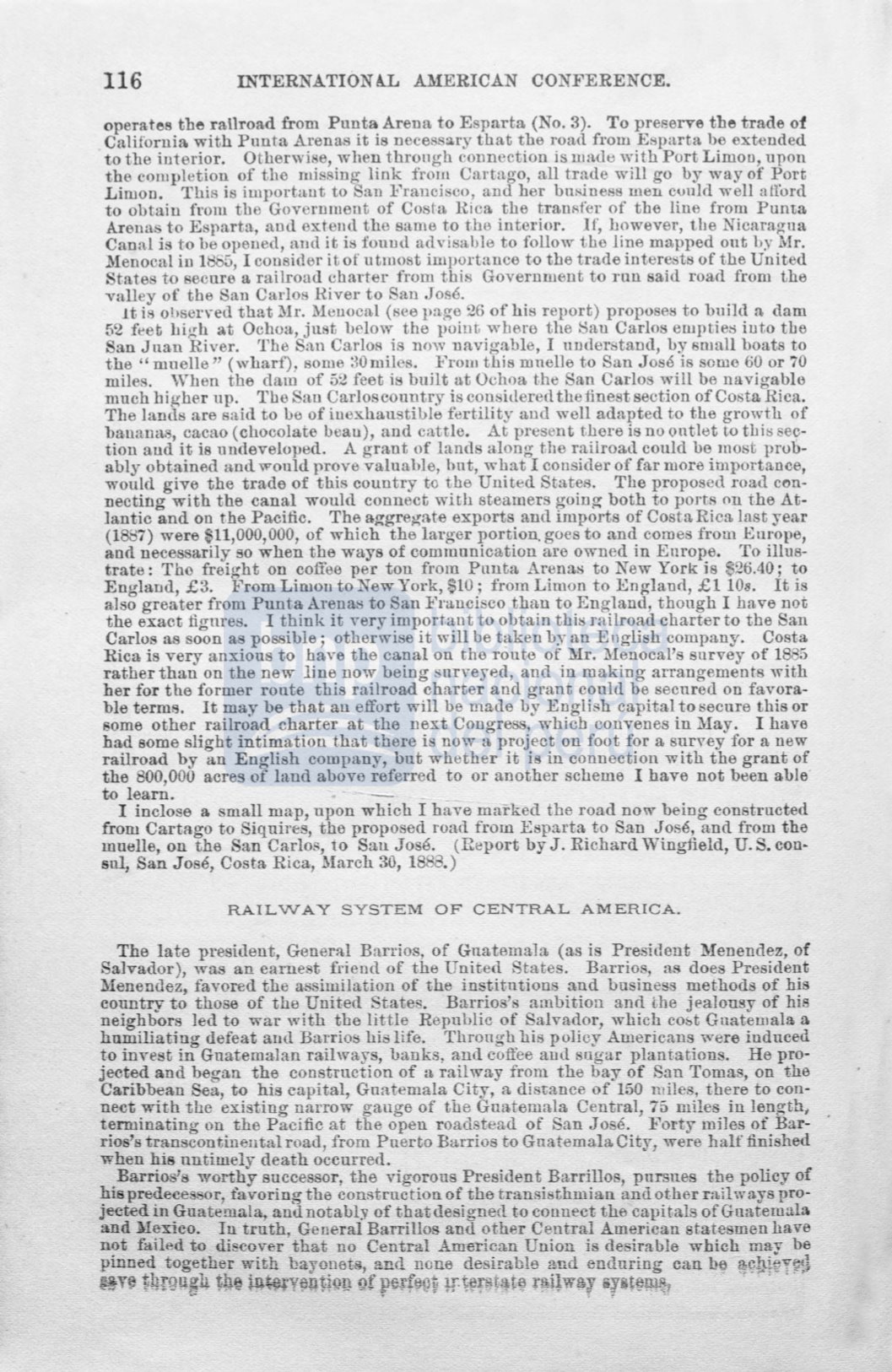

116
INTERNATIONAL AMERICAN CONFERENCE.
operates the ra.Hroad from Punta Arena to Esparta (No. 3). To preeerve the trade of
California with Punta Arenas it is neces ary that the road from Esparta be extended
to the interior. Otherwi e, when throngh connection ís maue with Port Limoo, upon
the corupletion of the missing link from Cartago, all trade will go by way of Port
Liruon. This is iruportaut toSan Franci co, and ber business men cvnld well alford
to obtaiu from tbe Governmeut of Costa Rica the transfer of tbe liue from Punta
Arenas to Esparta, aou exteuu the same to the interior.
lf,
bowever, the Nicaragua
Canal is to be opened, a11d it is found achisable to follow the line mapped out
hy
Mr.
Menocal in
1885,
I cousider it of utmost im}JOrtance to tbe trade interests of tbe United
tate to ecure a railroad chM·ter from this Government to 1·un said road from tbe
valley of tbe San Carlos River toSan José.
1t
i. o!>served that :Mr. Menocal (see page 26 of bis report) propo esto build a dam
52 fee!i
bi~h
at Ochoa, just below the poiut wbere the í:\an Carlos empLies iuto tbe
San Juan River. The San Carlos is now uavigable, I understand, by srnall boats to
tbe "muelle" (wbarf). sorne 30 mile .
:From this muelle to San J osé is seme 60 or 70
miles.
'Vhen the dam of 5::l feet is buílt at Ochoa the 'an Carlos will be navigable
much higher u p. Tbe San Carloscountry is con Íllered thefinest section of Costa Rica.
The lands are said to be of in xhaustible fertility and well adapted to the gro;dh of
banana , cacao (chocolate lJeau), and cattle. At present there is no ontlet to tbit; sec–
tion aud it ís undeveloped. A grant of lands along tho raiiroad could be mosb prob–
ably obtaíned and would prove valuable, bnt, wbat I consider of far more importance,
would give tbe trade of this country to the United States. The proposed road con–
necting with the canal would connect with steamers going both to port on the At–
lantic and on the Pacific. The
aggre~ate
exports and imports of Costa Rica last year
(1887)
were $11,000,000, of which tbe larger portion. goes to and comes from Europe,
and neces arily so when the ways of communication are owned in Enrope. To illus–
trate: Tho freight on coffee per ton from Punta Arenas to New York is S26.40; to
England, 1:3. From Liruon to New York, $10; from Limon to Englaun, EllOs.
It is
al o greater from Punta Arena· toSan Franci co than to England, thongh I have not
the exact figures.
I think it very important to obtain thb railroad charter to the San
Carlos as soon as possible; otherwíse ít wíll be taken by an English company. Costa
Rica is very anxious to baYe the canal on tbe route of Mr. .M:enocal's survey of
18
5
rather than on the new line now being surveyed, and in making arrangements with
her for the former route this railroad charter and grant could be secnred on favora–
ble terma.
It
may be that an effort will be made by English capital to oecure this or
some other railroad charter at the next Congress, whicb convenes in May.
I have
had sorne slight intimatiou that there i now a project on foot for a survey for a new
railroad by an En<rlísh company, bnt whetber it is in connection with the grant of
the 800,000 acres
of
land above referred to or another scheme I ha.ve not been able
to
learn.
I inclose a small map, upon which I have marked the road now being constructed
froru Cartago to Siqnire , the proposed road from Esparta toSan Jo. é, and from the
muelle, on the San Carlos, 1o San José.
(Report by J. Richard Wingfield, U. S. con–
sul, San José, Costa Rica, .March 30, 1888. )
RAILW"AY SYSTEM OF CENTRAL AMERICA.
The late president, Gener::tl Barrios, of Guatemala. (as is President Menendez, of
• alvador), was an carne
t
friend of the United • tates. Barrios, as does President
Menendez, favored the a!lsimilation of the institntion and business metbods of bis
country to those of the United
tates. Barrio 's a.mbition anii Lhe jealonsy of bis
neigbbors led to war with tbe little Repuhlic of Salvador, which co&t Guatemala a
hnmiliatiug defeat aml Barrios bis life. Throngh bis policy Americana were iudnced
to invest in Guatemalan railways, banks, and cofl'ee autl sngu.r plantations. He pro–
jected and began the construction of
a.
railway from the bay of San Toma , on the
Caribbean Sea, to bis capital, Guatemala City, a di ·tance of
150
ntiles, there to con–
nect with the existing narrow gauge of the Guatemala Central, 75 miles in length,
terruinating on the Pacific at the open road tead of San Jo é. Porty miles of Bar–
rios's tran continen
tal road, from Puerto Barrios to Guatemala. City, were half fi.nished
when his nntimely
dea.th occurred.
Barrios's worthy successor, the vigorous President Barrillos, pursnes the policy of
bis predece sor, favoring the construction of the transisthmian and otber railwa.ys pro–
jected
in
Guatemala, and notably of thatdesigned to connect the capitals ofGuatemala
and Mexico.
In truth, General Barrillos and other Central American tate men llave
n?t failed to dLcover that no Central American Union is de 'ral>le which may be
pmned togetber with bayonets, and none desirable and endnring can be a.c
i~"f~!l
n "llrqqg4
~h~ il+~Yf¡lltioD
9f
llerf~JQ$ !f~~mt!lt6
1'
Hway
ar~t~P.L
.... . ' ..
















